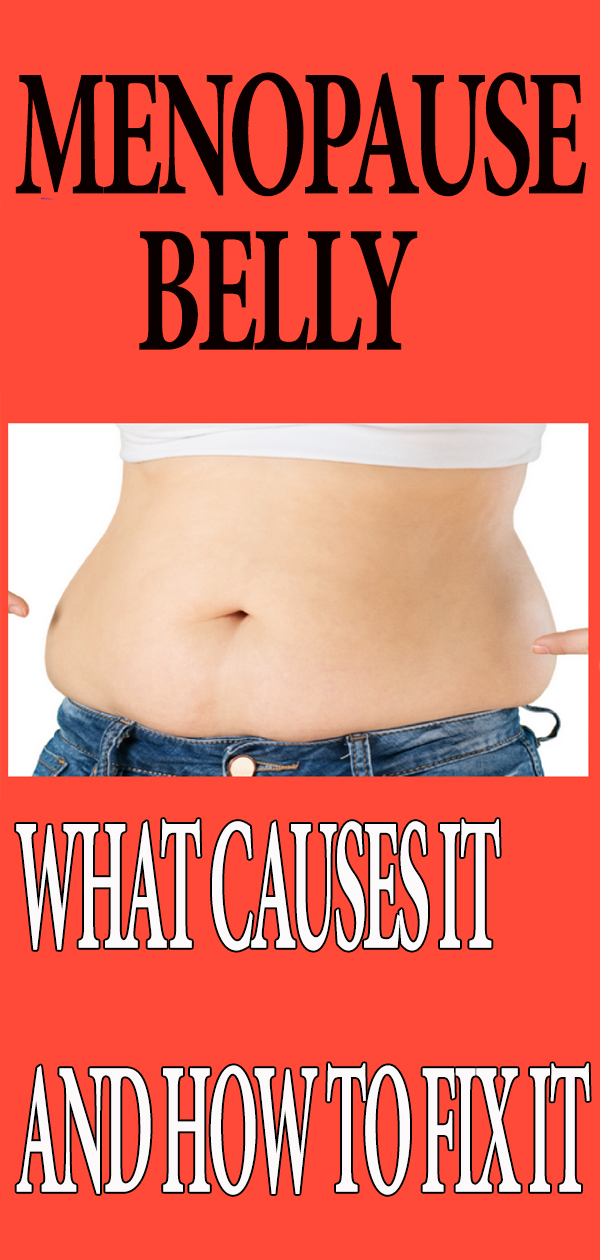For many postmenopausal women, one of the most vexing changes is a shift in body fat storage to the front and sides of their abdomen.
This phenomenon, also known as menopause belly, is a result of shifting hormones, activation of a “menopausal gene“, as well as changes in exercise and diet.
A decline in estrogen causes fat cells in the abdominal area to store more fat. It may even reduce your body’s ability to burn fat.
When the “menopause gene” is switched on, it contributes to belly fat. Here’s 3 simple ways women can turn this gene off.
Unfortunately, most women gain between five to ten pounds during the first decade after menopause.
Research shows that postmenopausal women have an increase in intra-abdominal and trunk fat when compared to premenopausal women.
The studies found that during early menopause, there’s an increase in intra-abdominal fat—the deeper visceral body fat. These changes were consistent across age and weight.
An increase in intra-abdominal fat is linked to a higher risk of high blood pressure, myocardial infarction, diabetes, and elevated cholesterol.
Therefore, this shift in body fat storage is more than just a cosmetic issue.
The decline in hormones during and after menopause is just one part of the menopause belly. For many women, their level of activity slows with age.
Many women don’t reduce their caloric intake to match the lowered activity. The lower activity level, coupled with a decline in muscle mass from less exercise, lowers the metabolic rate, leading to an increase in stored fat.
Although you don’t have much control over the hormonally induced body fat distribution, you can achieve a flatter tummy with the following tips.
Dietary Modifications
Reducing the menopause belly starts with a review of your diet as well. If you’re taking in more calories than you burn, the excess is stored.
The principal postmenopausal storage depot is the tummy. Our metabolism slows as we age, so the number of calories that you used to be able to eat without gaining weight has changed.
Taking a clear-eyed view of your diet and caloric intake is the first way to derail the slide into postmenopausal weight gain.
Aaptiv can help with those stubborn extra pounds. Open the Aaptiv app today to view our newest fitness classes.
Track What You Eat
The estimated caloric recommendation for moderately active women aged 55 and older is around 1,600 calories a day (less if sedentary or more if very active).
If you’re noticing your weight creeping up, keep a food diary for several days and calculate your daily caloric intake.
Doing this will enable you to pinpoint where your diet may be off track and give you a starting point for weight loss.
A simple way to kick-start fat loss is by reducing your daily caloric intake by 250 calories and upping your energy expenditure an extra 250 calories.
As an example, cutting out a mid-afternoon bag of chips will take care of the caloric reduction. Adding a 45-minute walk each day will add up to a 500 calorie daily reduction.
This equals 3,500 calories, or a pound of weight loss each week. It’s a painless way to achieve slow, stable weight loss.
For some postmenopausal women, part of the menopause belly issue is due to bloating. The usual culprits are foods that cause gas or water retention.
For some, the lactose in dairy products can cause bloating and stomach distress.
Also, the hormonal shifts after menopause can cause your body to retain fluids more easily, a good reason for limiting your sodium.
Processed foods tend to contain a lot of hidden sodium, as well as other less-than-healthy ingredients. Ideally, you should eat less than 2,300 mg of sodium a day, and even less if water retention is an issue.
Top Bloat Offenders
- Carbonated beverages.
- Vegetables, such as onions, broccoli, beans, cabbage, and Brussels sprouts.
- Soy products.
- Foods high in fructose (some processed foods, and fruits such as apples, cherries, watermelon, and pears).
- Sugar substitutes, such as sorbitol, mannitol, or xylitol (found in some chewing gums and sugar-free foods).
- High fiber foods. Although fiber is good for you, adding too much fiber (especially insoluble fiber) too quickly into your diet can cause bloating.
If you notice belly bloating after eating, keep a food record to determine which foods may be causing the problem. Try eliminating them from your diet to see if that helps.
Some women find that taking a probiotic product, especially those that contain the strain Bifidobacterium infantis, can help with bloating.
Exercise
You can reduce the appearance of your tummy by strengthening the muscles that support the core. Focus on exercises that’ll increase your muscle mass like those you can find in the Aaptiv app.
Although there’s an age-related reduction in muscle mass, you can significantly reverse that trajectory with a strength-training program.
Muscles are metabolically active. Part of the decline in metabolism with age can be attributed to the loss of this tissue.
Think a three-fold approach of cardio—higher intensity weight training (shorter reps with more challenging weight) and core exercises that strengthen the recti, transverse, and oblique muscle groups.
Core exercises won’t reduce abdominal fat, but strengthening the abdominal muscles increases belly support and tone. The transverse abdominal muscles function as a girdle for the area below your belly button.
Targeting that muscle group (see Sahrmann exercises link below) will help tighten the appearance of your menopause belly.
Abdominal Exercises
- Front and side planks
- Reverse crunches
- Medicine ball twists
- Sahrmann transverse exercises
Posture
When you think of an elderly person, you probably envision someone with a stooped, rounded back posture. The old person stoop isn’t inevitable.
You can improve your posture at any age with exercise. Activities, such as yoga and tai chi, along with cardio and strength training exercises, enable your body to maintain the strength and flexibility needed to keep your spine straight and your body standing tall.
Try doing the following exercises several times during your day to help reset your posture.
Wall Stand
Stand with your back against a wall and arms at your side with palms facing up. Slowly raise your arms overhead while maintaining contact with the wall and hold for five seconds. Return to start position and repeat several times.
Chin Tuck
Start by rolling your shoulders back and relax down. Look straight ahead, place two fingers on your chin, and tuck your chin straight back towards your shoulders. Hold for five seconds and repeat several times.
Doorway Stretch
Stand at an open doorway with your hands on either side of the door frame at shoulder height. Lean forward until you feel your chest muscles stretch. Hold for five seconds and repeat several times.
Be patient. It takes times to reset your body to the point where you see a change in your tummy.
You may need to continue to modify your diet or exercise to find that sweet spot where menopause belly fat starts to budge. Don’t give up if you don’t see changes right away.
Catherine Cram is an exercise physiologist and a leading expert in the field of maternal fitness. Her consulting company, “Prenatal and Postpartum Fitness” specializes in providing the most current maternal exercise information and continuing education courses to health and fitness professionals.


